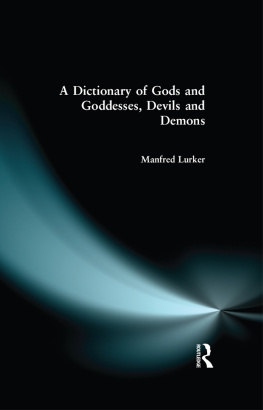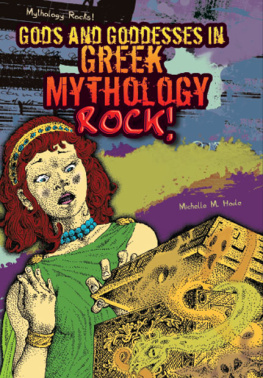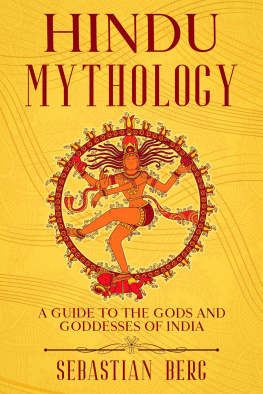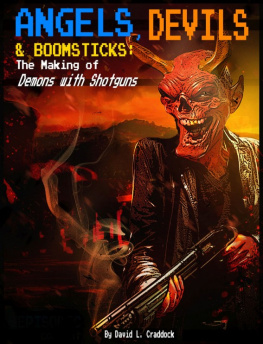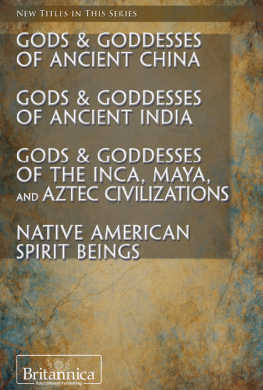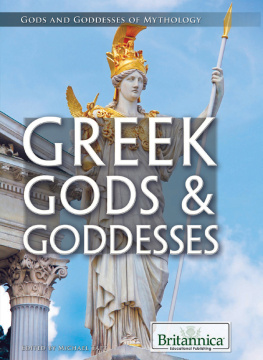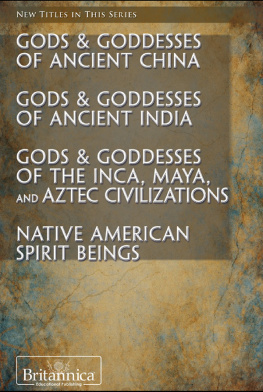Campbell G. L. - A Dictionary of Gods and Goddesses, Devils and Demons
Here you can read online Campbell G. L. - A Dictionary of Gods and Goddesses, Devils and Demons full text of the book (entire story) in english for free. Download pdf and epub, get meaning, cover and reviews about this ebook. City: London;New York, year: 2004, publisher: Taylor & Francis Group;Routledge, genre: Religion. Description of the work, (preface) as well as reviews are available. Best literature library LitArk.com created for fans of good reading and offers a wide selection of genres:
Romance novel
Science fiction
Adventure
Detective
Science
History
Home and family
Prose
Art
Politics
Computer
Non-fiction
Religion
Business
Children
Humor
Choose a favorite category and find really read worthwhile books. Enjoy immersion in the world of imagination, feel the emotions of the characters or learn something new for yourself, make an fascinating discovery.
- Book:A Dictionary of Gods and Goddesses, Devils and Demons
- Author:
- Publisher:Taylor & Francis Group;Routledge
- Genre:
- Year:2004
- City:London;New York
- Rating:3 / 5
- Favourites:Add to favourites
- Your mark:
- 60
- 1
- 2
- 3
- 4
- 5
A Dictionary of Gods and Goddesses, Devils and Demons: summary, description and annotation
We offer to read an annotation, description, summary or preface (depends on what the author of the book "A Dictionary of Gods and Goddesses, Devils and Demons" wrote himself). If you haven't found the necessary information about the book — write in the comments, we will try to find it.
A Dictionary of Gods and Goddesses, Devils and Demons — read online for free the complete book (whole text) full work
Below is the text of the book, divided by pages. System saving the place of the last page read, allows you to conveniently read the book "A Dictionary of Gods and Goddesses, Devils and Demons" online for free, without having to search again every time where you left off. Put a bookmark, and you can go to the page where you finished reading at any time.
Font size:
Interval:
Bookmark:

Dictionary of
GODS AND GODDESSES, DEVILS AND DEMONS
Dictionary of
GODS AND GODDESSES, DEVILS AND DEMONS
Manfred Lurker
Translated from the German by G. L. Campbell

Reprinted 1988, 1989, 1994, 1996, 1997, 2000, 2001
2003 (twice), 2004 by Routledge
11 New Fetter Lane, London EC4P 4EE
29 West 35th Street, New York NY 10001
First published in German in 1984 as
Lexikon der Gtter und Dmonen
by Alfred Kramer Verlag, Stuttgart
This translation first published in 1987 by Routledge & Kegan Paul Ltd
Set in 9/10 Ehrhardt
by Columns Ltd., Reading
and printed in Great Britain
T F International Ltd, Padstow, Cornwall
Routledge is an imprint of the Taylor & Francis Group
This translation Routledge & Kegan Paul 1987
No part of this book may be reproduced in any form without permission from the publisher except for the quotation of brief passages in criticism
Library of Congress Cataloging in Publication Data
Lurker, Mandred.
Dictionary of gods and goddesses, devils and demons.
Translation of Lexikon der Gtter und Dmonen. 1984.
Bibliography: p.
1. Mythology Dictionaries. 2. Demonology Dictionaries. I. Title.
BL303.L8713 1987 291.210321 8621911
British Library CIP Data also available
ISBN 0-415-03943-6 (c)
ISBN 0-415-03944-4 (p)
Contents
A basic element in all religions is the awareness, both intellectual and emotional, of mans dependence on non-human powers: powers which we conceive as personal, and vis--vis which we normally stand in a reciprocal relationship. Gods and demons are the forms taken by these powers, their hypostatizations, as it were, in the shape of light and darkness, sun and moon, fire and water, bird and snake. The divine can reveal itself in all the phenomena of nature, just as the demonic can. But it is not only from without that the numinous presents itself to man: it can arise spontaneously in religious experience as an exponent of feeling (Wilamowitz-Moellendorf), and it can be divined as a dark abyss which is not accessible to our reason (Rudolf Otto). The images generated in the human mind are, then, representative of stages reached in mans understanding and in his knowledge of himself; in a certain sense, indeed, every divine image has traits which identify it as a self-projection of mankind. As ideal beings, the gods are what man would like to be; but they are also what he, in his spatio-temporal imperfection, cannot be.
Every religion has its own conventions and symbols which serve to express the functions, the aspects and the spheres of competence of the members of its pantheon. And this means that the conscious and unconscious nexus of conventions specific to any one religion is hardly, if at all, accessible to believers in another religion, or to those who believe in no religion at all. Thus, even for the ancient Greeks the animal gods of the Egyptians were shocking and revolting. And modern man, proud as he is of his reason and logic, fares no better when he is called upon to recognize an authentic view of God in the often and in the most literal sense obscure rites and images of an alien religion.
Above all, we must not fail to recognize that the concepts god and demon are by no means evenly weighted in the various religions. The innumerable deities of Hinduism and Buddhism carry about as much significance as angels or saints do in monotheistic religions. There are mortal gods, gods who die (like Balder and Osiris) and demonic beings whom death cannot touch (for example, the Devas). The border-line between gods and demons is fluid (see Asura, or the Nymphs); and with the Christianization of a people, its erstwhile deities can be devalued to the status of devils (as in the case of Pan or Dabog) or accepted into the corpus of Christian saints (for example, Brigit Knds). From the largely anonymous mass of spirits, gods and demons are distinguished by being more sharply and individually characterized, as shown, for example in the bestowal of names upon them.
The present reference work offers a conspectus of all the more important supernatural beings who have acquired personality in this sense, both in the pantheons of the classical cultures and in the world religions of today; and the religious systems of the so-called primitive races are also given their due place. Any attempt at an exhaustive survey of all the names, functions, symbols and attributes in this field was excluded from the outset: the mass of material is such that even several volumes could hardly cope with it. Heroic figures in saga and legend have been included only where this is justified by their subsequent deification: thus, Aeneas and Herakls are included, while the Celtic King Arthur and the Germanic hero Siegfried are not. The same goes for founders of religions, and for saints: the reader will find Buddha and Lao-zi in these pages, but neither Muhammad nor Zarathustra. Mythological detail has been intentionally cut to a minimum. There is no entry for Christ: for various reasons, adequate treatment of this figure lies outside the scope of the present work. The readers attention is directed particularly to the two appendices, in which the individual gods and demons are classified from various points of view.
The illustrations serve only to lighten the text, and are not intended to be in any way a scientifically exact iconography. It should be borne in mind that in the case of certain cultures it is hardly possible to find suitable matter for illustrative purposes and that certain peoples and religions have a pronounced antipathy to images and representation of any sort.
Manfred Lurker
Oberkirch, May 1984
1 Greek and Latin English forms in general currency are used instead of their Greek or Latin equivalents: thus, Jupiter for Iup(p)iter, Centaurs, Nymphs, etc. Apart from these special cases, Greek and Latin names are taken as in the original German text, with changes in spelling where necessary. Head-words in the original text carry stress-marks based on: H. Hunger, Lexikon der griechischen und rmischen Mythologie, 6th edn, 1969. These are retained.
2 Sanskrit and Vedic Standard transcription is used for Sanskrit and Vedic names, based on Macdonell, Sanskrit-English Dictionary, OUP, 1924. The distinction between the dental series: t, d, n, s; the retroflex series: , , , ; and the palatal series: c, j, , , has been retained. Here, and are both pronounced as sh; , , are the same sounds as are heard in English t, d, n; t, d, n are their continental counterparts (as in Italian); is the Spanish .
3 The sh sound where it otherwise occurs particularly in ancient Near Eastern and Egyptian names is transcribed as . This letter also represents sh in the two Baltic languages, Lithuanian and Latvian. In Yoruba, sh is represented by .
4 Chinese For Chinese names the modern pinyin romanization has been used, though tone marks have been disregarded; x is something like the sh in ship, q is like the ch in cheese; p, t, k are heavily aspirated; b, d, g are not voiced.
5 Wherever it occurs, is pronounced as j in French journal.
6 In Aztec and Maya names, c before e and i = s; before a, o, u = k.
Aatxe (Basque, young bull) Evil spirit in the shape of a bull which, the Basques believe, leaves its cave on stormy nights, and which may often assume human form. Under the name Etsai (i.e. devil) it instructs its devotees in its arts.
Next pageFont size:
Interval:
Bookmark:
Similar books «A Dictionary of Gods and Goddesses, Devils and Demons»
Look at similar books to A Dictionary of Gods and Goddesses, Devils and Demons. We have selected literature similar in name and meaning in the hope of providing readers with more options to find new, interesting, not yet read works.
Discussion, reviews of the book A Dictionary of Gods and Goddesses, Devils and Demons and just readers' own opinions. Leave your comments, write what you think about the work, its meaning or the main characters. Specify what exactly you liked and what you didn't like, and why you think so.

